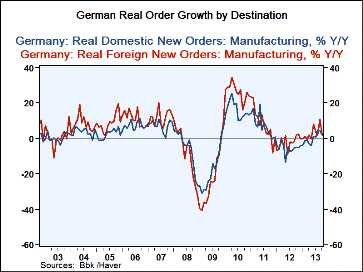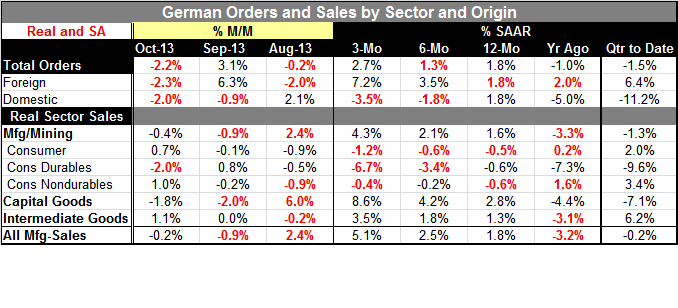 Global| Dec 06 2013
Global| Dec 06 2013German Orders Step Back
Summary
German orders fell hard in October after an even stronger surge in Sept. September saw a sharp pullback in both foreign and domestic orders. But the foreign pullback followed a stronger surge in September while the domestic setback [...]
 German orders fell hard in October after an even stronger surge in Sept. September saw a sharp pullback in both foreign and domestic orders. But the foreign pullback followed a stronger surge in September while the domestic setback followed a drop in September.
German orders fell hard in October after an even stronger surge in Sept. September saw a sharp pullback in both foreign and domestic orders. But the foreign pullback followed a stronger surge in September while the domestic setback followed a drop in September.
While both domestic and foreign orders are up by 1.8% year over year, foreign orders are on a tear despite the month's setback. Foreign orders accelerate from 1.8% over 12-months to 3.5% at an annual rate over six-months to 7.2% at an annual rate over 3-months. In comparison, domestic orders are contracting at a 1.8% annual rate over six-months and contracting at a 2.5% rate over 3-months.
Germany, the strongest economy in Europe, is having its industrial sector stoked by external demand while domestic demand is contracting. This is not the kind of leadership role we would like to see Germany playing in this business cycle.
We would like to see the German economy thriving and pumping up its own domestic demand, so that while Germany's exports were thriving its own domestic demand could be partly satisfied by output from fellow EMU members. But that is not the case here. Germany is being stimulated by its weaker EMU counterparts. Germany's orders tell us that the country is diverting that demand so that it is no longer helping to raise output in those fellow member countries; instead it is stoking output in Germany.
In the fourth-quarter-to-date, German total orders are down at a 1.5% annual rate. This drop is led by an 11.2% annual rate drop in domestic orders (or in German domestic demand). Meanwhile, German foreign orders are up at a 6.4% annual rate. Germany is growing based on foreign demand and that strength is offsetting demand weakness in the German domestic economy.
It is unclear what this drop off in German domestic demand means. Germany always has export-led growth. The strength in German orders from abroad suggests that other economies are doing well. By this time in the expansion we would have expected a bit more life from German domestic demand. But since Germany is not an economy that typically exerts a locomotive effect on the rest of Europe I don't see its `orders weakness' as a harbinger of anything since the weakness is essentially domestic.
Still the Bundesbank has just lifted its outlook for the German economy. Today it raised its estimate for growth this year to 0.5%, up from its June prediction of 0.3%. It also increased its outlook for growth in 2014 to 1.7% from 1.5%.

Robert Brusca
AuthorMore in Author Profile »Robert A. Brusca is Chief Economist of Fact and Opinion Economics, a consulting firm he founded in Manhattan. He has been an economist on Wall Street for over 25 years. He has visited central banking and large institutional clients in over 30 countries in his career as an economist. Mr. Brusca was a Divisional Research Chief at the Federal Reserve Bank of NY (Chief of the International Financial markets Division), a Fed Watcher at Irving Trust and Chief Economist at Nikko Securities International. He is widely quoted and appears in various media. Mr. Brusca holds an MA and Ph.D. in economics from Michigan State University and a BA in Economics from the University of Michigan. His research pursues his strong interests in non aligned policy economics as well as international economics. FAO Economics’ research targets investors to assist them in making better investment decisions in stocks, bonds and in a variety of international assets. The company does not manage money and has no conflicts in giving economic advice.






